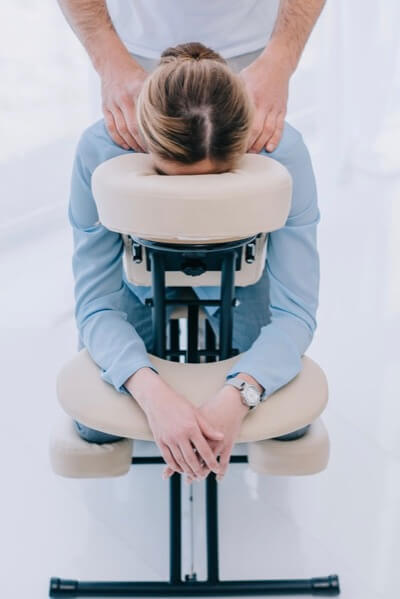- Home
- Western Massage
- Chair Massage
As an affiliate with Bookshop, Amazon, and other programs, I may earn revenue from qualifying purchases through affiliate links. This does not affect the price you pay. Privacy Policy / Disclosures. This site is for educational purposes only.
Search this site:
What Is Onsite Chair Massage and Its Benefits and Techniques?
Onsite chair massage first appeared in the workplace in the late 1980s, introduced by David Palmer, who developed the first specialized massage chair.
Studies have found that chair (or seated) massage reduces stress and increases energy levels among employees. The massage also helps relieve neck, shoulder, and arm tension that contribute to repetitive stress injuries among workers. Companies benefit in the form of increased productivity, lower absenteeism, and higher morale.
But onsite chair massage therapy isn't limited to the workplace. You'll find massage kiosks set up in malls and airports and at trade shows, conventions, or sporting events. A portable massage chair can go almost anyplace!
The advantages of seated massage are that it's convenient (you keep your clothes on), fast (from 5 to 30 minutes long), and affordable. The massage typically focuses on relieving tension in your back, neck, shoulders, and arms.
Seated Massage Techniques
The techniques for an onsite chair massage are different from typical massage therapy techniques. Some of the traditional Swedish massage techniques don't translate well to massage in a chair because they involve gliding strokes that don't work well over clothing. Common techniques for massage in a chair include:
- Compression techniques, including acupressure, are common in seated massage. David Palmer trained in Amma massage, an ancient system of acupressure techniques, and many massage therapists have trained in his system.
- Squeezing techniques are often done on large muscle groups and muscles that are not firmly attached to underlying structures.
- Kneading techniques are circular movements.
- Percussion (or tapotement) are stimulating techniques are what many people call karate chops.
Palmer advocates a standard massage routine and discourages treatment during seated massage, but other massage therapists disagree and do offer treatment. For example, see Ralph Stephens' book Therapeutic Chair Massage. So, like all massage therapy, seated massage offers a variety of opportunities for both the massage therapist and the client.
Palmer Chair Massage Technique
The Palmer chair massage technique refers to a structured massage sequence created by David Palmer based on traditional Japanese acupressure (Amma). The sequence and its correct application are best learned from a teacher. The following is a summary.
Shoulder, Arm, and Hand Techniques
- Use your palms to compress the muscles along the spine at five points from shoulders to lower back.
- Palm press along the edge of the left shoulder blade, followed by a forearm press along the top of the left shoulder.
- Use your elbow to apply pressure to three lines of points on the left side:
– Start between the shoulder blade and spine at the base of the neck and apply pressure to nine points from the base of the neck to the point opposite the bottom of the shoulder blade.
– Start at the inner top edge of the shoulder blade and moving downward and apply pressure to four points along the inside edge of the shoulder blade.
– Apply pressure to three points on the top of the shoulder. - Move to the left arm, squeezing the upper arm twice and then applying pressure with your thumbs along the outside of the upper arm.
- On the lower arm, apply pressure with your thumbs along an inside, middle, and outside line.
- Massage the hand with techniques such as spreading the hand and massaging the space between the bones.
Repeat the shoulder and arm techniques on the right side.
Back and Hip Techniques
- Double palm press the muscles along the spine at five points from the bottom of the shoulder blades to the sacrum.
- On the left back, start at the point on the spinal muscles in line with the bottom of the shoulder blade, and use your thumbs, one on top of the other, to press nine points from the shoulder blade to the sacrum.
- Find the point just underneath the 12th rib. Press that point, the point just below it, and the point just above the top of the hip bone.
- Repeat steps 1–3 on the right side.
- Single palm press three points just below the top of the hip bone on both sides of the hips at the same time, moving from the outside of the hips.
- Brush lightly down the spine twice.
Neck Techniques
- Move to the left side of the neck.
- Use your thumb to apply pressure to the point at the midline base of the skull.
- Move outward, applying pressure on four other points.
- Apply pressure to five points on each of three lines on the side of the neck. The first line is next to the spine, the second line is a thumb's width further out, and the third line is another thumb's width out.
- Finish by applying pressure again to point five on each of the three lines. Repeat on right side.
Finishing Techniques
To end the massage:
- Stretch the neck.
- Massage the scalp.
- Use the forearms to press along the top of both shoulders.
- Apply pressure to a few additional points on the trapezius muscle.
- Do a chest stretch.
- Use percussion techniques along the muscles next to the spine.
Source: TouchPro Chair Massage Student Manual and my workshop experience.





